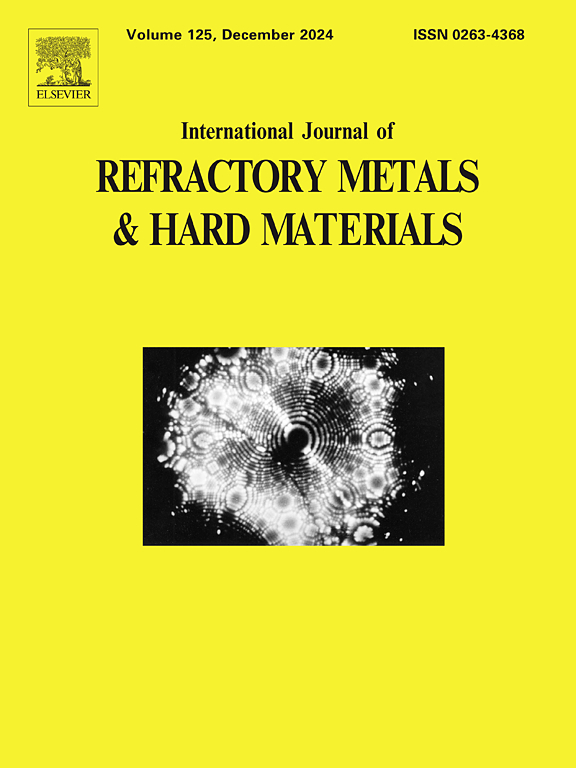Microstructure evolutions of liquid phase sintered W-Ni-Fe alloy under gravity
IF 4.6
2区 材料科学
Q2 MATERIALS SCIENCE, MULTIDISCIPLINARY
International Journal of Refractory Metals & Hard Materials
Pub Date : 2025-06-24
DOI:10.1016/j.ijrmhm.2025.107297
引用次数: 0
Abstract
In this paper, the microstructure evolutions of liquid phase sintered W-Ni-Fe alloys under different parameters (1460 °C/1, 15, 30 min) are observed based on the optical microscope (OM) and scanning electron microscope (SEM). With the prolongation of sintering time, irregular W particles gradually become spheroidized. However, due to the sedimentation of W particles caused by gravity, the microstructure is layered in the height direction after 1460 °C/30 min. Dendrites are formed in the top region because of the segregation of Ni and Fe. W grains become denser towards the bottom, in which the area fraction can be up to 73 %. In addition, the relative sliding between particles leads to shear force in the W particles and Ni![]() Fe matrix under gravity, causing local stress concentration and cracks. Therefore, the selection of appropriate sintering technology has an important effect on the microstructure of the tungsten alloy, which can avoid the generation of dendrites and cracks.
Fe matrix under gravity, causing local stress concentration and cracks. Therefore, the selection of appropriate sintering technology has an important effect on the microstructure of the tungsten alloy, which can avoid the generation of dendrites and cracks.

重力作用下液相烧结W-Ni-Fe合金的组织演变
采用光学显微镜(OM)和扫描电镜(SEM)观察了液相烧结W-Ni-Fe合金在1460°C/1、15、30 min条件下的显微组织演变。随着烧结时间的延长,不规则W颗粒逐渐球化。1460°C/ 30min后,由于重力作用导致W颗粒沉积,显微组织在高度方向呈层状,顶部区域由于Ni和Fe的偏析形成枝晶。W晶粒向底部致密,面积分数可达73%。此外,颗粒之间的相对滑动导致W颗粒和NiFe基体在重力作用下产生剪切力,导致局部应力集中而产生裂纹。因此,选择合适的烧结工艺对钨合金的显微组织有重要的影响,可以避免枝晶和裂纹的产生。
本文章由计算机程序翻译,如有差异,请以英文原文为准。
求助全文
约1分钟内获得全文
求助全文
来源期刊
CiteScore
7.00
自引率
13.90%
发文量
236
审稿时长
35 days
期刊介绍:
The International Journal of Refractory Metals and Hard Materials (IJRMHM) publishes original research articles concerned with all aspects of refractory metals and hard materials. Refractory metals are defined as metals with melting points higher than 1800 °C. These are tungsten, molybdenum, chromium, tantalum, niobium, hafnium, and rhenium, as well as many compounds and alloys based thereupon. Hard materials that are included in the scope of this journal are defined as materials with hardness values higher than 1000 kg/mm2, primarily intended for applications as manufacturing tools or wear resistant components in mechanical systems. Thus they encompass carbides, nitrides and borides of metals, and related compounds. A special focus of this journal is put on the family of hardmetals, which is also known as cemented tungsten carbide, and cermets which are based on titanium carbide and carbonitrides with or without a metal binder. Ceramics and superhard materials including diamond and cubic boron nitride may also be accepted provided the subject material is presented as hard materials as defined above.

 求助内容:
求助内容: 应助结果提醒方式:
应助结果提醒方式:


